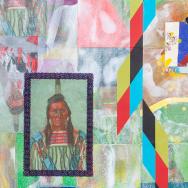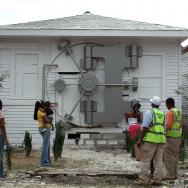When Abigail Winograd began planning the largest art exhibition of her career, she did not expect it to open in the middle of a pandemic.
Three years ago, Winograd was selected to put together a show that would illuminate key social issues, including the links between public health and environmental crises and the tragic costs of racial and economic disparities.
The global outbreak of COVID-19 has only underscored the magnitude of these conditions, adding gravity to a sprawling art exhibition that the University of Chicago’s Smart Museum of Art has organized with more than two dozen partners around the city.
“[2018] felt like a moment of political and social urgency,” Winograd said. “But we were just at the tip of the iceberg of what we were really going to experience.”
Winograd is the Smart Museum of Art’s curator for “Toward Common Cause: Art, Social Change, and the MacArthur Fellows Program at 40.” The city-wide exhibition explores art’s potential for social impact and celebrates the 40th anniversary of the John D. and Catherine T. MacArthur Foundation’s Fellows Program, which awards no-strings-attached grants annually to individuals with extraordinary creative potential, including visual artists.
Created in collaboration with 19 University and local partners and supported through a grant from the MacArthur Foundation, “Toward Common Cause” showcases the work of 29 MacArthur fellows—including Mel Chin, Nicole Eisenman and Kara Walker—whose art often raises questions about or proposes speculative solutions to contemporary social problems.
With installation openings scheduled from May 2021 to January 2022, “Toward Common Cause” exemplifies the Chicago-based foundation’s enduring commitment to its home city and the provocative, wide-ranging work of the individuals who have received fellowships over the past four decades.
“We wanted to do something more than just a typical celebration for the 40th anniversary, and we wanted to find a way to bring the work of fellows to audiences that may not have the opportunity to see that work easily or readily,” said Don Meyer, a senior program officer at the MacArthur Foundation who specializes in the arts.
Meyer said the Smart Museum was “a natural partner” for the exhibition: It provided the foundation with an opportunity to both help build partnerships and leverage academic scholarship in a way that would highlight the relationship between art objects and the broader culture.
“We were really happy to see the way the Smart took this out into the world, working not only with more traditional museum and gallery spaces, but with community exhibition venues and service providers, as well,” Meyer said, noting that Winograd and her collaborators worked closely with exhibition partners and artists to build trust and forge strong relationships across Chicago.
The Smart Museum’s own galleries are hosting part of “Toward Common Cause” through Dec. 19, displaying works by Mark Bradford, Toba Khedoori, Julie Mehretu and many others. Also on campus, UChicago’s Logan Center for the Arts is presenting an installation by Carrie Mae Weems through Dec. 12, while the Neubauer Collegium for Culture and Society will open an installation by Ida Applebroog on Oct. 14.
Many works are also being displayed outside of museums and art galleries, the result of efforts by organizers and community-oriented partners to reach a wider audience. These installations range from Iñigo Manglano-Ovalle’s active hydrant—which can be used to water a community garden at the nonprofit Sweet Water Foundation—to public murals by Njideka Akunyili Crosby, one of which will cover the façade of the Chicago Housing Authority’s Minnie Riperton Apartments.
“An encounter with an art object that prompts a conversation or changes the way you see things can actually change the way that we think [as a society], and create civil discourse around the issues that we’re facing as a country,” Winograd said.
For “Toward Common Cause,” the curator said she and her colleagues at the Smart built on longstanding partnerships and sought out organizations “whose values were consonant with the exhibition.” She added that many of the installations will be permanent: As such, the partnerships will endure beyond the timeframe of the exhibition, ensuring that they aren’t “blips” in the cultural conversation.
The new exhibition also builds on the Smart’s own history of public engagement, which includes collaborations with the Sweet Water Foundation since 2017; an interpreter-in-residence program that began in 2013; and programs for K-12 students that have been ongoing for decades.
David Levin, the senior advisor to the provost for arts at UChicago, is excited about the ways in which “Toward Common Cause” serves as a “remapping of artistic collaboration across the city” and an opportunity for faculty, staff and students to discover new art in new places around Chicago.
The Smart and the MacArthur Foundation, he added, are examining how artistic expression can “meet the challenges of the moment at the highest aesthetic and conceptual level.”
Levin—who also serves as the Alice H. and Stanley G. Harris Jr. Distinguished Service Professor of Germanic Studies, Cinema and Media Studies, and Theater and Performance Studies—said he sees an animating philosophy in the exhibition that echoes and builds upon what UChicago scholars have worked on for years.
He noted in particular the work of Prof. Theaster Gates, the founder of UChicago’s Arts + Public Life (APL) program, as well as efforts by later APL leaders Prof. Jacqueline Stewart and Assoc. Prof. Adrienne Brown. Together, their work highlights “how art can engage with and transform our thinking about the public sphere in unusual and unpredictable ways,” Levin said.
The Stony Island Arts Bank, which Gates restored in 2015, is hosting a “Toward Common Cause” installation, as is APL’s Washington Park Arts Incubator.
Among the artists exhibiting work in “Toward Common Cause” is Mel Chin, a North Carolina-based visual artist who received a MacArthur Fellowship in 2019. Chin brings to Chicago his long-running, crowd-sourced “Fundred Project.”
Anyone can participate with a single drawing —a self “minted” hundred dollar bill that Chin collects and displays to value an individual’s voice in the call for government action to address the threat that lead-contamination in homes, water and soil poses to children. A downloadable template is available on the Fundred website for those who would like to draw and mail a Fundred from home.
Chin has also created a new, permanent installation for the exhibition titled “Safehouse Temple Door.” A huge steel door reminiscent of historic bank vaults, the door hangs over the entrance to the Sweet Water Foundation’s Civic Arts Church. Although a safe is typically used to secure valuable objects and keep them away from others, Chin has manipulated the door to perform an inverse function: keeping those who enter safe.
“It’s a safe that’s meant to unlock imagination, undo exclusive access; meant to be cracked open by the community,” he said. “Because what’s valuable is health and creativity for the people who will use it.”
Chin noted that the door was designed such that even a child can slide it apart, despite its imposing size. “Safehouse Temple Door” is one of several installations that are already open. Other portions of “Toward Common Cause” will open in the fall, with some stretching into 2022. They await more visitors—and, in some cases, participants who can help shape the art itself.
“The Fundred vision is meaningless without Sweet Water, meaningless without your drawing, and meaningless without every other community in Chicago,” Chin said. “It’s a ‘we’ project to bring about an urgent policy action … and ultimately, I just want to be a delivery person.”

